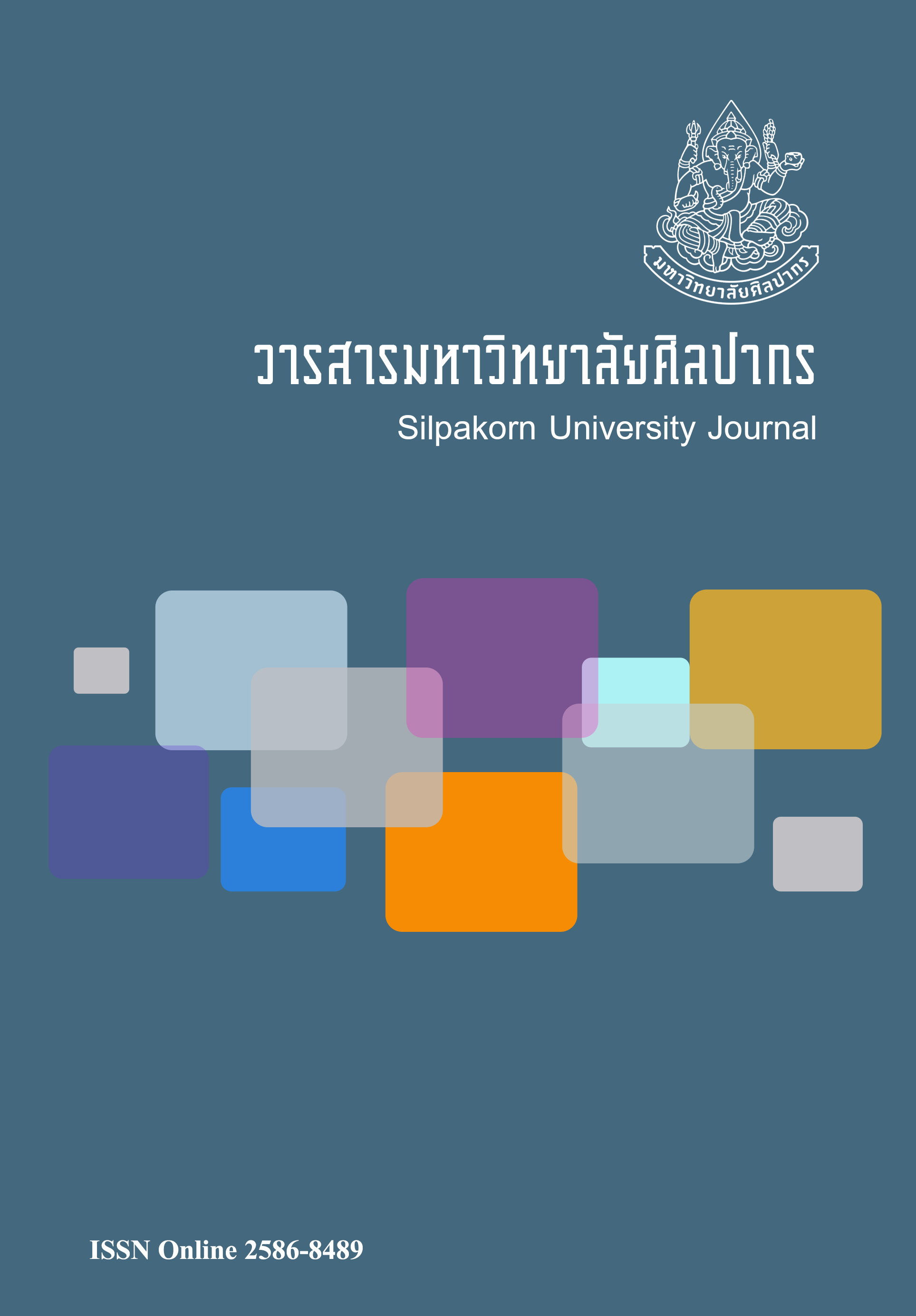งูในฐานะสัญลักษณ์สื่อคุณลักษณะของพระศิวะ (Serpents as a symbol representingthe characteristics of the God Shiva)
Main Article Content
Abstract
บทความวิจัย “งูในฐานะสัญลักษณ์สื่อคุณลักษณะของพระศิวะ” เป็นงานวิจัยเชิงเอกสาร มีวัตถุประสงค์เพื่อศึกษาความหมายเชิงสัญลักษณ์ของงู และเพื่อศึกษาว่าสัตว์ประจำพระองค์ของเทพเจ้าที่ไม่ได้ทำหน้าที่เป็นสัตว์พาหนะ สามารถแสดงคุณลักษณะของเทพเจ้าพระองค์นั้นได้หรือไม่ โดยใช้งู สัตว์ที่ปรากฏคู่กับพระศิวะเสมอเป็นกรณีศึกษา ทฤษฎีและกรอบแนวคิดที่ใช้ในการวิจัยคือ ทฤษฎีสัญวิทยาของแฟร์ดิน็อง เดอ โซซูร์ กรอบแนวคิดของไฮน์ริช ซิมเมอร์ว่าสัตว์พาหนะของเทพเจ้าแสดงสัญลักษณ์และพลังงานของเทพเจ้า และกรอบแนวคิดการตีความเทพปกรณัมในเชิงสัญลักษณ์และอุปลักษณ์ของโจเซฟ แคมพ์เบลล์ ผู้วิจัยเก็บข้อมูลความหมายเชิงสัญลักษณ์ของงูจากเอกสารหลัก 4 เล่ม แล้วนำความหมายเชิงสัญลักษณ์ของงูที่ปรากฏมากที่สุดมาศึกษาเปรียบเทียบกับคุณลักษณะของพระศิวะตามที่ปรากฏในเทพปกรณัมของศาสนาพราหมณ์-ฮินดู ผลการศึกษาพบว่าความหมายเชิงสัญลักษณ์ของงูที่พบมากที่สุด 8 อันดับแรกได้แก่ 1) น้ำ/ฝน 2) ความอุดมสมบูรณ์ 3) ผู้พิทักษ์ 4) การฟื้นคืนชีพ/การเกิดใหม่ 5) การรักษาเยียวยา 6) ปีศาจ/ความชั่วร้าย 7) ปัญญา/ความรู้ และ 8) พลัง/ความแข็งแกร่ง ความหมายเชิงสัญลักษณ์ของงูทั้ง 8 ข้อสอดคล้องกับคุณลักษณะของพระศิวะดังที่ปรากฏในเทพปกรณัมพราหมณ์-ฮินดู จึงสรุปได้ว่าสัตว์ประจำพระองค์ของเทพเจ้า ถึงแม้จะไม่ได้ทำหน้าที่เป็นพาหนะก็สามารถทำหน้าที่เป็นสัตว์สัญลักษณ์ของเทพเจ้าและแสดงคุณลักษณะของเทพเจ้าพระองค์นั้นได้ ทั้งนี้สัตว์ประจำพระองค์กับสัตว์พาหนะของเทพเจ้าอาจแสดงคุณลักษณะของเทพเจ้า เหมือนหรือแตกต่างกันแล้วแต่กรณี
The article “Serpents as a Symbol Representing the Characteristics of the God Shiva” is a documentary research. The objectives of this research are as follows: 1) to study symbolic meanings of serpents 2) to study whether animals which always presented with gods, but do not act as the gods’ vehicles, can be considered as symbolic animals of the gods. Serpents, which are repeatedly shown in Shiva’s icons, were used as a case study. Theoretical frameworks used in this study consist of semiotics theory of Ferdinand de Saussure, Heinrich Zimmer’s concept stating that any animals serving as a god’s vehicle represent symbols and energies of that god, and Joseph Campbell’s concept suggesting that mythology be symbolically and metaphorically interpreted. Researcher collected symbolic meanings of serpents from 4 main books and then compared the most found symbolic meanings of serpents with characteristics of Shiva as described in Hindu myths. It has been found that the most found symbolic meanings of serpents can be divided into 8 categories as follows: 1) water/rain 2) fertility 3) protector 4) resurrection/rebirth
5) healing 6) devil/evil 7) wisdom/knowledge and 8) power/strength. All the symbolic meanings are related to the characteristics of Shiva as mentioned in Hindu myths. Thus, it was concluded here that the animal which constantly presented with a particular god can function as symbolic animal of the god and show characteristics of that particular god even though it does not serve as vehicle of the god. However, the shown characteristics of the two symbolic animals could be similar or different on a case by case basis.
Article Details
References
Boonsong, B. (2015). Symbolic animal in Mythology: a case study of nandi of the God Shiva (สัตว์สัญลักษณ์ในเทพปกรณัม : กรณีศึกษาโคนนทิของพระศิวะ). Journal of Communication Arts Review. 19(1), 260-274.
Campbell, J. (2002). The inner reaches of outer space. California: New World Library.
Campbell, J. (2008). The power of Myth (พลานุภาพแห่งเทพปกรณัม) (B. Boonsong,Trans.). Bangkok: Amarin Printing and Publishing.
Charoensinolarn, C. (2002). Semiology, Structuralism, Post-Structuralism and the study of Political Science (สัญวิทยา โครงสร้างนิยม หลังโครงสร้างนิยม กับการศึกษารัฐศาสตร์). Bangkok: Viphasa.
Cirlot, J. E. (2002). A dictionary of symbols (2nd ed.). New York: Dover Publications.
Colum, P. (1996). Nordic gods and heroes. New York: Dover Publications.
Cooper, J. C. (2015). An illustrated encyclopaedia of traditional symbols. (2nd ed.). New York: Thames&Hudson.
Ellis Davidson, H. R. (1990). Gods and Myths of Northern Europe (2nd ed.). London: Penguin Books.
Grant, R. J. (2014). Edgar Cayce on angels archangels and the unseen forces. Virginia: A.R.E Press.
Hamilton, E. (2006). Mythology (ปกรณัมปรัมปรา) (N. Veohong, Trans.).Bangkok: Amarin Printing and Publishing.
Kanchanakul, S.(2007).The important mahadevas (มหาเทพองค์สำคัญ) . Bangkok: Setasilpa.
Littleton, C. S. (Ed.). (2002). Mythology: the illustrated anthology of world Myth & Storytelling. London: Duncan Baird Publishers.
Macdonell, A. (2012). Vedic Mythology. Kentucky: Forgotten Books.
Martin,R.P.(2003). Myths of the Ancient Greeks. New York: New American Library.
Phra Bat Somdet Phra Poramentharamaha Vajiravudh Phra Mongkut Klao Chao Yu Hua.(2013) Gods and things we should know (เทพเจ้าและสิ่งน่ารู้). Bangkok: Sripanya.งูในฐานะสัญลักษณ์สื่อคุณลักษณะของพระศิวะ20บารนี บุญทรง
Phraya Satchaphirom. (2005).The origin of Gods (เทวกำเนิด) (13th ed.). Bangkok: Amarin.
Rosen, B. (2009).The Mythical creatures Bible. New York: Sterling Publishing.
Schomp, V.(2010). Myths of the World: Ancient India. New York: Marshall Cavendish-Benchmark.
Sor Plynoi. (2009). Animals of the Himalayas (สัตว์หิมพานต์) (4th ed.). Bangkok:Pimkham Books.
Sor Plynoi. (2010). The fight between Garuda and Naga: The Myths of the origins of Garuda and Naga (ครุฑยุดนาค : ตำนานว่าด้วยกำเนิดแห่งครุฑและพญานาค) Bangkok: Pimkham Books.
Sor Plynoi. (2012). Mythology (เทวนิยาย) (4th ed.).Bangkok: Gypsy.
Stiver, D. (1996).The philosophy of religious language: sign, symbol, and story. Massachusette: Blackwell Publishers.
Thailand Bible Society. (2006). Thai-English Bible (พระคริสตธรรมคัมภีร์ไทย-อังกฤษ) (4th ed.). Bangkok: Thailand Bible Society.
The Royal Institute. (1997). Dictionary of phrases in Thai literature during Ayuddhya period Lilit Ongkarn Chang Nam (พจนานุกรรมศัพท์วรรณคดีไทย สมัยอยุธยา ลิลิตโองการแช่งน้ำ). Bangkok:Mahachulalongkornrajavidyalaya University Press.
Vanamali. (2013). Shiva: stories and teachings from Shiva Mahapurana. Vermont: Inner Traditions.
Wilkins, W. J. (2012). Hindu Mythology: Vedic and Puranic. Kentucky: ForgottenBooks.
Wilkinson, K. (Ed.). (2008). Signs & symbols: an illustrated guide to their origins and meanings. New York: DK Publishing.
Wilkinson, R. H.(2003) The complete gods and goddesses of Ancient Egypt. New York: Thames & Hudson.
Yaemnadda, S.(2004).Myths of Bharata (ภารตนิยาย) (3rd ed.). Bangkok: Maekhamphang.
Zimmer, H.(1992) Myths and symbols in indian art and civilization. New Jersey: Princeton University Press

